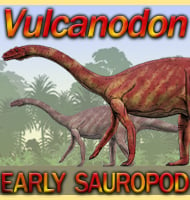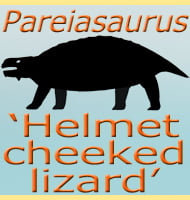In Depth
Streptospondylus could have become the first dinosaur to be scientifically recognised. Starting in 1770 vertebrae and limb remains were steadily recovered and over the course of the following years many fossils for separate locations were collected before being sent to the Museum National d’Histoire Naturelle in Paris, France in 1800. These fossils were then added to collections from further areas by one Georges Cuvier. In 1808 Georges Cuvier, one of the pioneers of comparative anatomy as well as one of leading naturalists of his time finally put forward a scientific description of the bones. However the concept of large reptilian creatures like dinosaurs was still many years away and so when Cuvier described a vertebra that we now know belonged to a theropod dinosaur, he believed that what he was dealing with were the remains of crocodiles.
Building upon the work of Henry De La beche, Cuvier realised in 1822 that the fossils he had previously described were actually from differing time periods. Cuvier did not specify names for these fossils, but in 1824 he outlined that there were two types. Also in 1824, the first creature that would later be known as a definitive dinosaur was named Megalosaurus and as such this is why Megalosaurus is down in history as the first dinosaur genus to be named and described. However the actual term dinosaur would still not be coined for another eighteen years. In 1825 another naturalist named Etienne Geoffroy Saint-Hilaire created a new genus of crocodile called Steneosaurus based upon two skulls. This new genus included the theropod dinosaur vertebrae, though it was still not realised what this was.
Eventually in 1932 the German palaeontologist Christian Erich Hermann von Meyer was studying Steneosaurus fossils and identifying several fossils that should have belonged to other genera, including the marine crocodile Metriorhynchus. von Meyer also found the theropod vertebrae, and since this was many years after the much publicised discovery of the first dinosaur genera, specifically Megalosaurus, von Meyer was quick to realise what it was. That year von Meyer established Streptospondylus altdorfensis as a new genus.
In 1842 the British naturalist Richard Owen (who in the same year established the dinosaurs as a group for the first time) took issue with the type species name of Streptospondylus. Because Streptospondylus altdorfensis was based upon fossils once attributed to Steneosaurus rostrominor, Owen believed that the type species should be written as Streptospondylus rostromajor since it was based from the earlier species, and when establishing this he assigned an attributed skull as holotype. Owen was also responsible for greatly increasing the number of Streptospondylus species from this time, creating S. major in 1842, S. recentor and S. meyeri in 1851 and S. Grandis in 1854. All four of these species are today considered to have been based upon fossils of Iguanodon, the second dinosaur genus named, as well as an ornithischian dinosaur that is considerably different to theropods which are saurischian dinosaurs.
Owen also named one more species in 1842 however. S. cuvieri was described from a single damaged vertebra. In 1861 Owen assigned the original material described by Cuvier to S. cuvieri even though S. rostromajor would technically have priority because it was named first. In 1923 a braincase of a theropod was also assigned to S. cuvieri by Jean Piveteau on the basis that it was recovered from the same approximate area as the earlier fossils.
Things began to change in 1964 when the palaeontologist Alick Walker renamed Streptospondylus cuvieri as a new species of Eustreptospondylus, E. divesensis, the braincase serving as the holotype. Later in 1977 two other palaeontologists named P. Taquet and S. P. Welles used the braincase to establish a new theropod genus, Piveteausaurus. In 2001 Ronan Allain stated that there is no connection between the braincase and the older theropod fossils that were included with it and that only the braincase could be used to indicate Piveteausaurus as a genus. Allain also proved that the skull which was designated the holotype for Streptospondylus rostromajor by Owen in 1842 was in fact a composite fossil of more than one creature. With the holotype for S. rostromajor disproven as valid, the older name of S. altdorfensis was resurrected as the type species of Streptospondylus. Today only the definitely theropod fossils of the original assignments are considered the valid fossils, and S. cuvieri reduced to very little distinctive material is now widely regarded as a Nomen dubium.
With so little fossil material known for this genus not much is known about this dinosaur. As a theropod it would have been a bipedal dinosaur and probably a predator of other dinosaurs. The full size of Streptospondylus cannot be definitely established, but it has been estimated to be around seven meters long, based upon comparisons to more complete theropod genera. Another theropod genus named Magnosaurus is popularly believed to have been a close relative of Streptospondylus. In fact Gregory S. Paul informally named Magnosaurus as a species of Streptospondylus, S. nethercombensis, in 2010, though to date Magnosaurus is still regarded as a valid genus by most palaeontologists.
Further Reading
- A quantity of bones found in the rocks in the environs of Honfleur, by the late Abb� Bachelet, G. Cuvier - 1800. - Sur les ossements fossiles de crocodiles et particuli�rement sur ceux des environs du Havre et d’Honfleur, avec des remarques sur les squelettes de sauriens de la Thuringe, G. Cuvier - 1808. - Recherches sur l’organisation des gavials, E. Geoffroy Saint-Hilaire - 1825. - Report on British fossil reptiles, Richard Owen - 1842. - Triassic reptiles from the Elgin area: Ornithosuchus and the origin of carnosarus, A. D. Walker - 1964. - Redescription du cr�ne de dinosaure th�ropode de Dives (Normandie) [Redescription of a theropod dinosaur skull from Dives (Normandy)], P. Taquet & S. P. Welles - 1977. - Redescription de Streptospondylus altdorfensis, le dinosaure th�ropode de Cuvier, du Jurassique de Normandie [Redescription of Streptospondylus altdorfensis, Cuvier’s theropod dinosaur from the Jurassic of Normandy], R. Allain - 2001.










